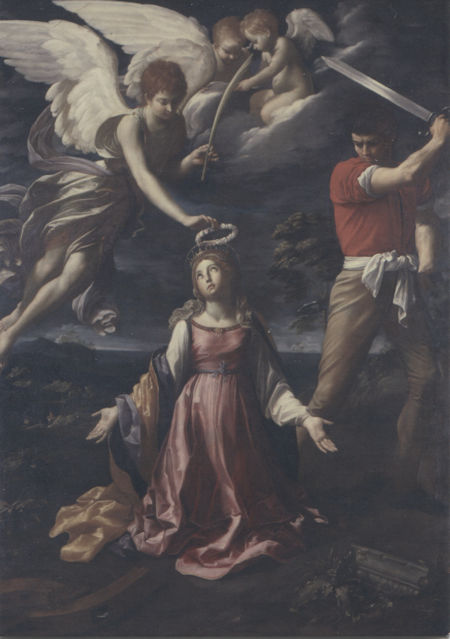You may not find this terribly rewarding unless you're included here, so this is a good time for casual and random browsers to turn back before they get too caught up in the sweep and majesty of the proceedings and can't let go.
27 October 2018
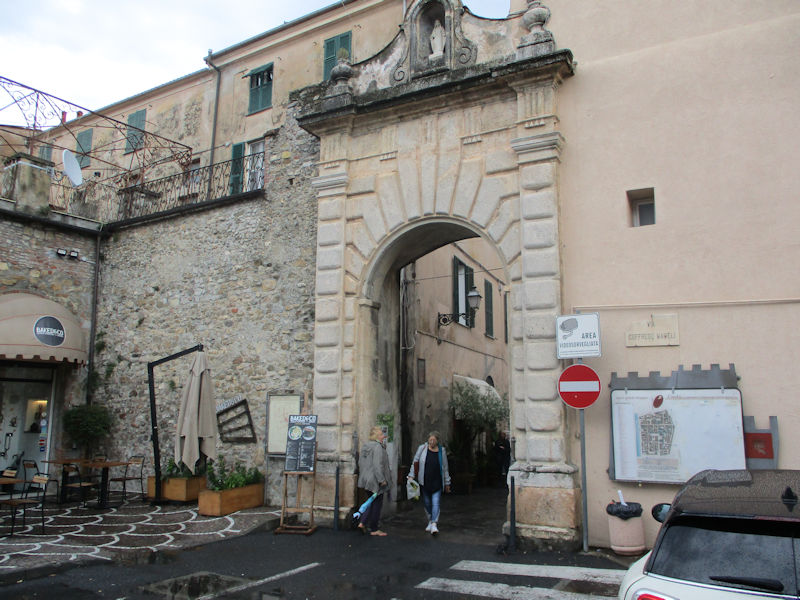
We've been given to understand that Albenga, on the Ligurian coast in the province of Savona, is a must-see, so we're here to see. This is a western city gate into the centro storico -- we've lucked onto a parking spot just outside it, on the Via Leonardo da Vinci, no less, next to a supermarket that happily stocks cat food, and just on the left here we note a bar that offers burgers and 'jacket potatoes', which we've filed away as useful information.

We're proceeding into the historic city centre down the Via Torlaro -- it has been and will continue raining on and off all day, a precursor of the appalling storms that battered all of Italy in subsequent days.

Albenga, like a great many other Italian cities, is known as 'the city of a hundred towers', though only a few of them are left. That's our first one.

We're on the Via delle Medaglie d'Oro, unfortunately perpendicular to the Good Stuff; we quickly get sorted out and hurry on. Albenga began life as the capital of the territories of the Ligurian Ingauni tribe, which supported Hannibal's Carthaginian invaders in the Second Punic War -- it was used as a naval base by Hannibal's brother Magone, whence he attacked and sacked Genoa in 205 BC. The settlement was taken over by the Roman authorities in 181 BC, gained Latin legal rights in 89 BC, under the Latin name Albingaunum, and was granted Roman citizenship by Julius Caesar in 45 BC. The construction through the town of the Via Julia Augusta in 13 BC, linking Piacenza with Arles in France and eventually Spain, brought a measure of prosperity.

Now we're on track for the Duomo (probably). Albenga took a bad hit in the early 5th century AD as the Visigoths were passing by after their Sack of Rome on their way to settling in southwestern France, but the general/emperor Constantius III rebuilt and fortified it not long after. In 451 it became the seat of one of the oldest Christian dioceses in Liguria.

We've got our backs to the Duomo, looking out at the Piazza San Michele. By the 11th century Albenga was one of the leading sea trading ports and in 1098 it played an important part in the First Crusade, which provided the red cross motif of the city's coat of arms. At the same time, it established itself as a free commune and supported Frederick I Barbarossa in his attempts to bring northern Italy under the imperial heel -- he recognized Albenga as a imperial city in 1159, and it remained a loyal Ghibelline city stronghold through succeeding centuries, though in 1251, following the death of its protector the Emperor Frederick II 'Stupor Mundi', it passed into the control of nearby Genoa.

That's the Duomo, the Cattedrale di San Michele Arcangelo, and its campanile.

An earlier church was on the site since about AD 400, but this structure was built in about 1100, with major renovations in the late 12th century and again in the 1580s. It's said that a restoration of the 1970s made a point of removing post-medieval excrescences. The belltower dates from the 1390s. The Duomo's enjoying its mid-day siesta just now, so we'll return in a little while.

Which raises the question of how to spend the time until it reopens. Some of us are looking forward to a random stroll round town in the drizzly rain, whilst others are thinking back to the café with the 'jacket potatoes'.
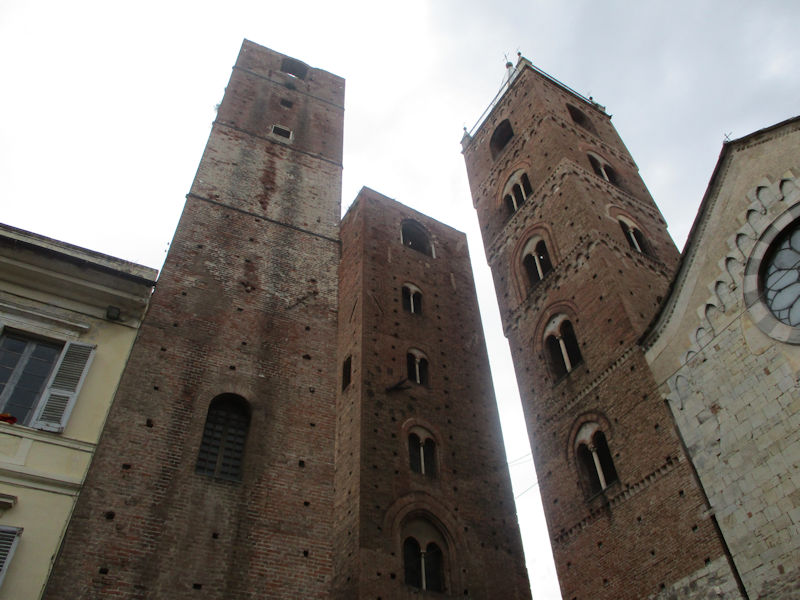
But we'll be back. We've got the baptistery to do, too.

Alongside the Duomo, that's the Chiesa di Santa Maria in Fontibus

The Duomo and the three towers, and the old City Hall, with its own belltower that still rings out (we're told) for city council meetings

At the far end of the Piazza San Michele, the Belle Epoque Cafè, with no outdoor customers today, and on the right, the 16th century Palazzo Peloso Cepolla.

A small park between the two churches, with a rather good statue dedicated to the glory of all the heroes 'in all the wars'. At this point, we're roughly in the centre of the roughly quadrilateral historic medieval walled town, roughly 400m along its longest measurement, 250m through its shortest diameter.
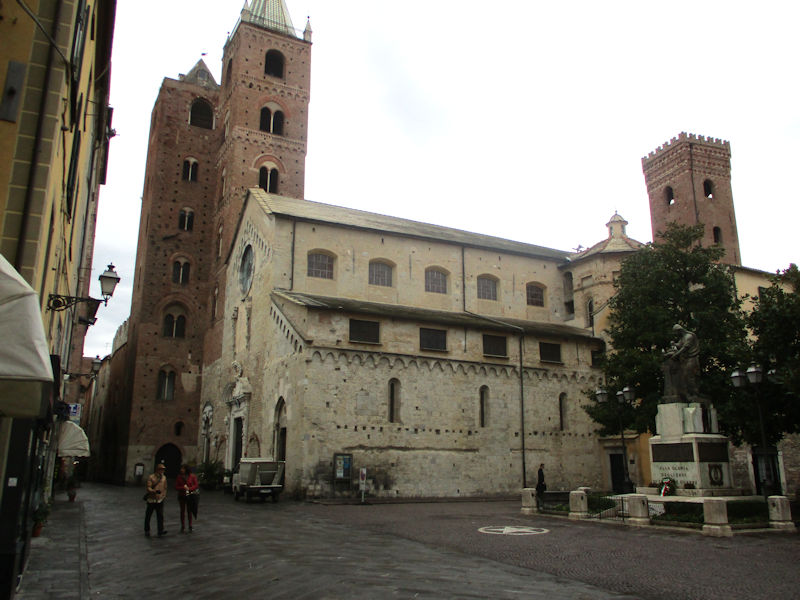
Albenga is an attractive little city of about 25,000 citizens on the Mediterranean Sea that also runs up the northern bank of the river Centa nearly 5km towards the Ligurian mountains, in fact, to the interchange of the coastal Autostrada A10 (European E80), called the AutoFiori, 'highway of flowers', opened in 1971 -- it runs all down the Ligurian coast 30km from Savona and on some 60km to Ventimiglia by the border with France, not far from Monaco and Nice. The locals are said to be referred to as, errm, the Ingauni or Albenganesi.

Farther along past the Duomo towards the far or SW end of the historic old town at the Piazza del Popolo. The city is also known for, among other tourist opportunities (like the remains of a Roman amphitheatre), its 4km of good beaches and a 3km seaside promenade. The local cuisine is prized (though some of its favorites, like focaccia and farinata, are not to my taste).

We're passing the Chiesa di Santa Maria in Fontibus now, closed of course. The 'fontibus' may refer to miraculous springs or fountains over which the basilica was built by Benedictine monks, first mentioned in 1098, though no signs of them have been found. There was reconstruction in the early 17th century and then again in the early 20th. We're not going to get into this one, we lament. Priorities!
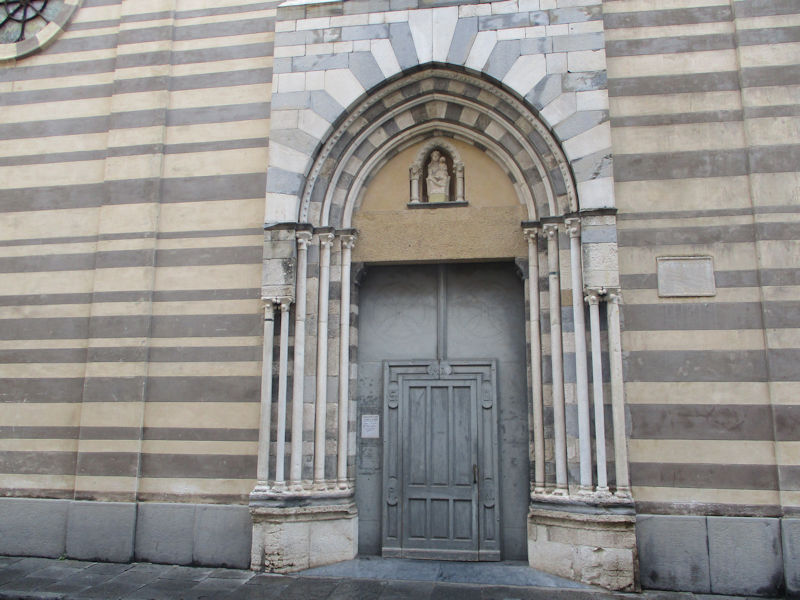
The front door is quite nice, anyway.
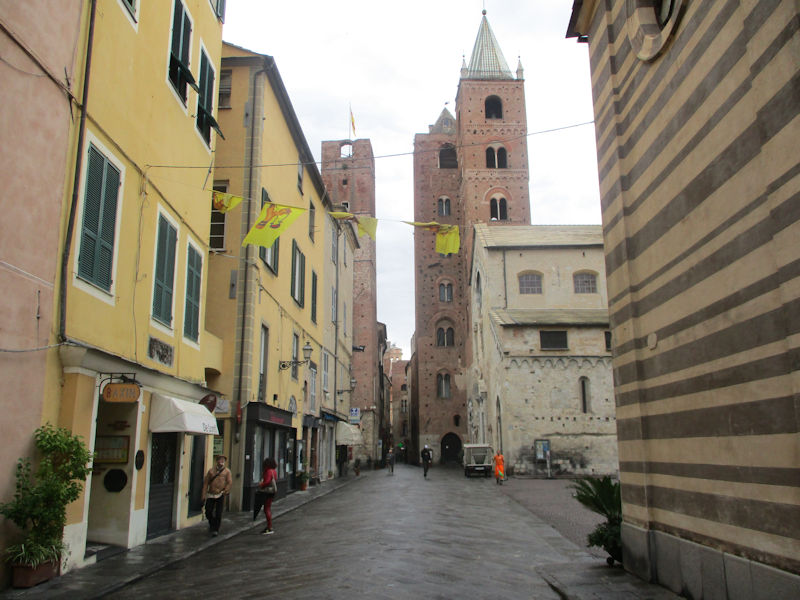
Looking back up the Via Enrico d'Aste, named for the mayor of Albenga, 1855 to 1863, during the nation's transformation from the Kingdom of Sardinia to the Kingdom of Italy, and with several terms later in the 1880s.
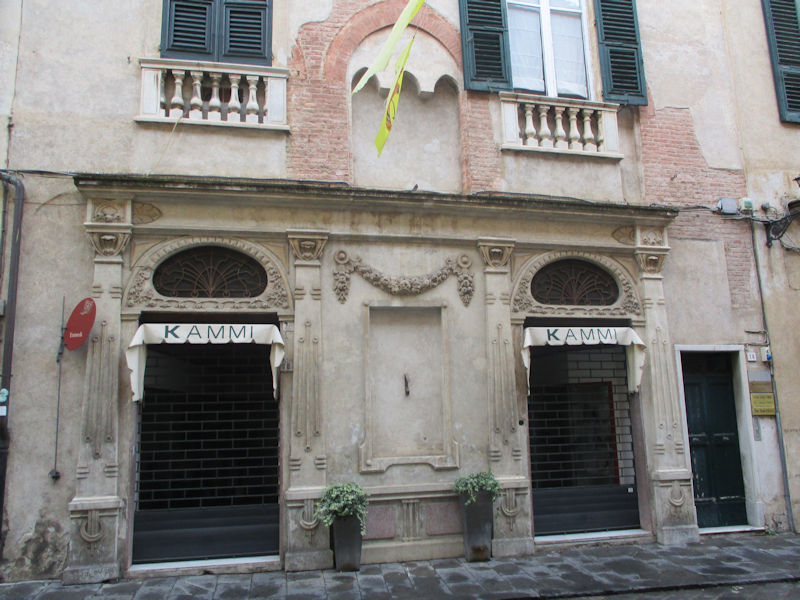
More unfilled niches
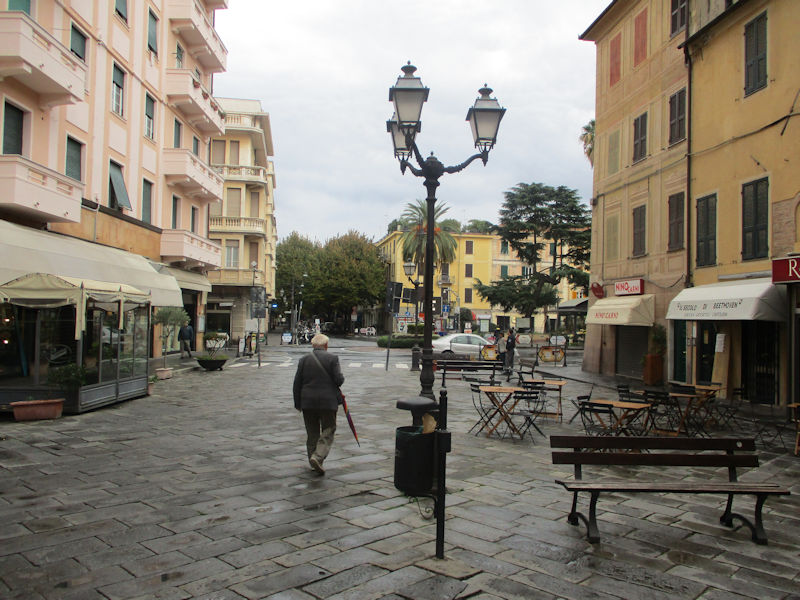
Toward the southeastern side of the centro storico and the Piazza del Popolo

They're everywhere, they're everywhere!

Across the Piazza del Popolo, the Bank Carige
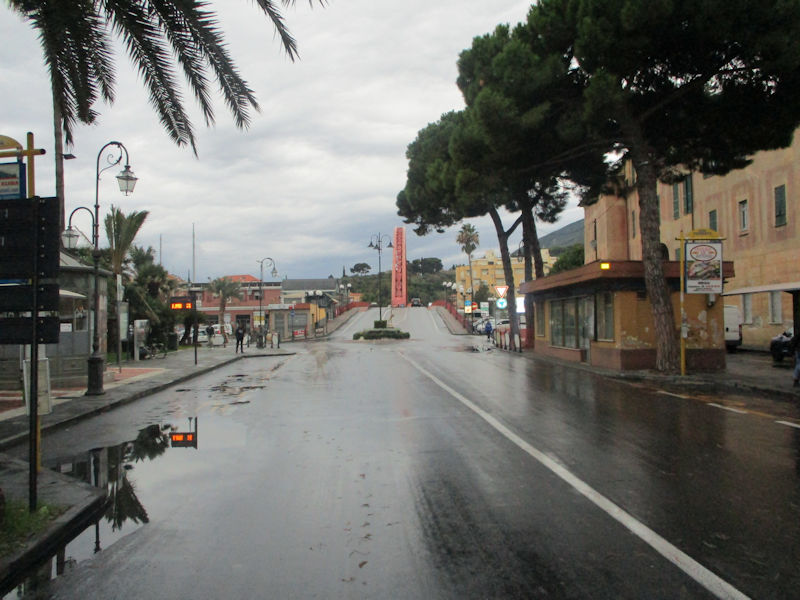
The SP39 road runs through town and over the bridge on the river Centa, past the . . .

. . . nearly 100m long Piazza, with its convivial restaurant in the middle, now hopelessly out of season.

It's time to visit the interesting bridge.
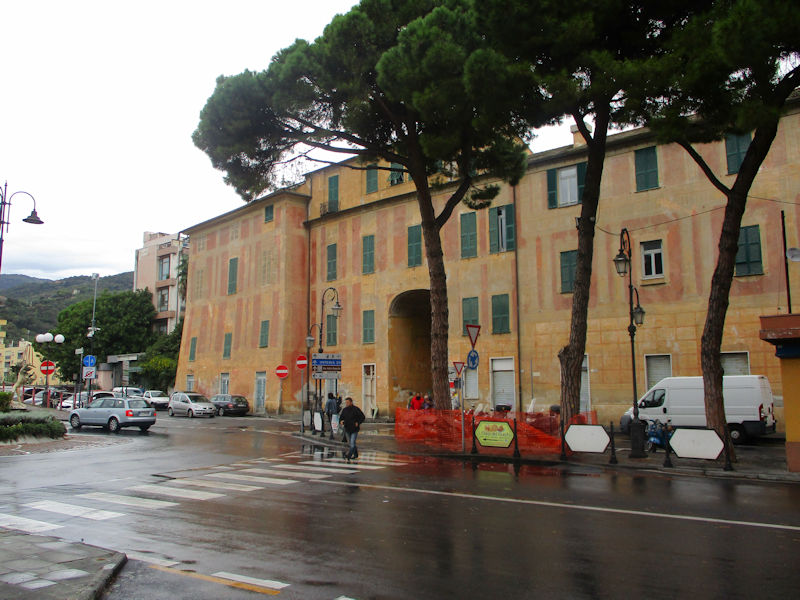
Buildings that were part of or replaced the city wall

We're not far from the Japanese/Chinese restaurant, where you can have a wonderful time, at the 'Time Wonderful'.

(Who were they trying to fool with those fake windows?)
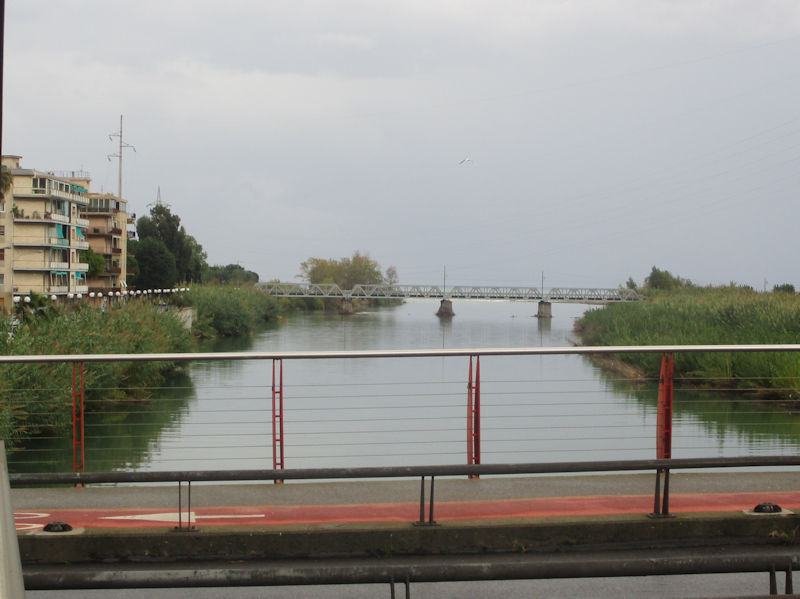
From the bridge, here's a zoom photo of the Centa to the Mediterranean, a kilometre away.
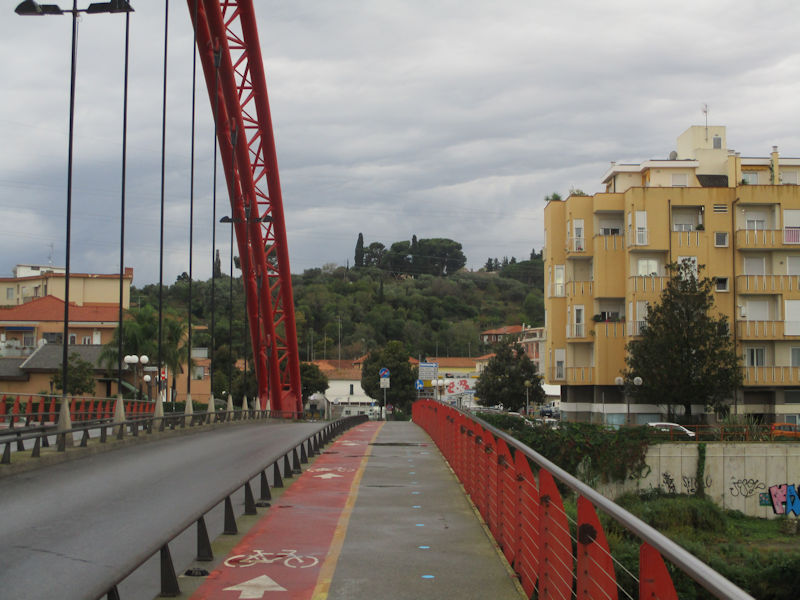
This is the 'Red Bridge of Albenga', built in a single arch without pillars in 1995 after a flood of 1994 destroyed the old one.
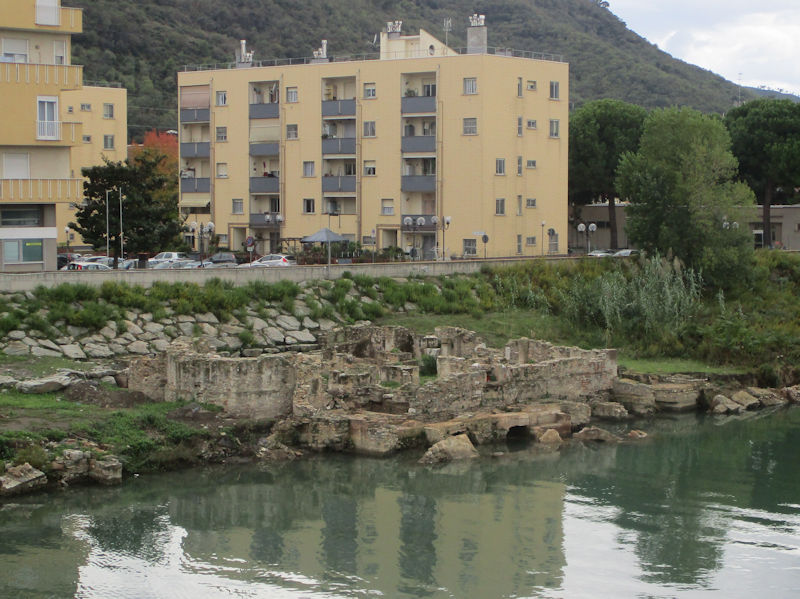
Ruins of, apparently, a former church -- that looks like what's left of an apse sticking out of the left end.
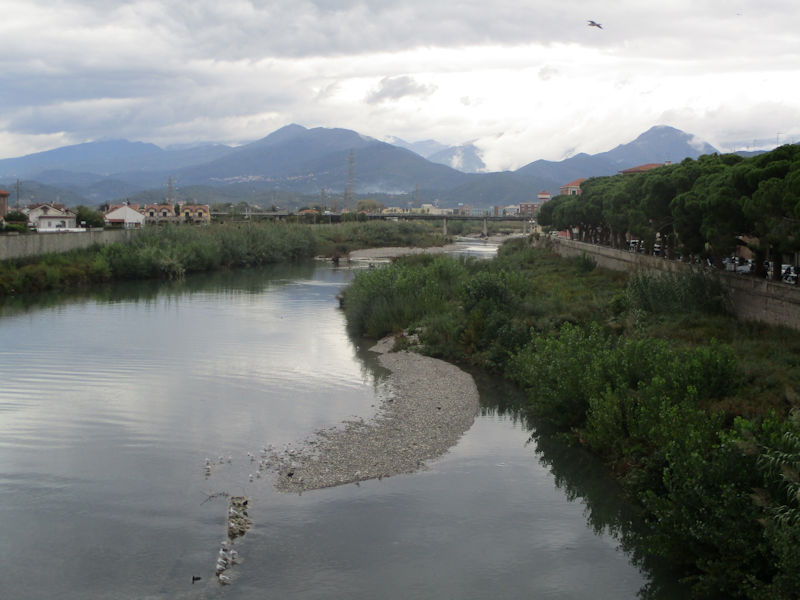
Looking upriver, to the west, into the Ligurian Alps

Back into the old town

Albenga street scene

Inside the old city walls, there is a road running along often under passages.

Along the Via Roma
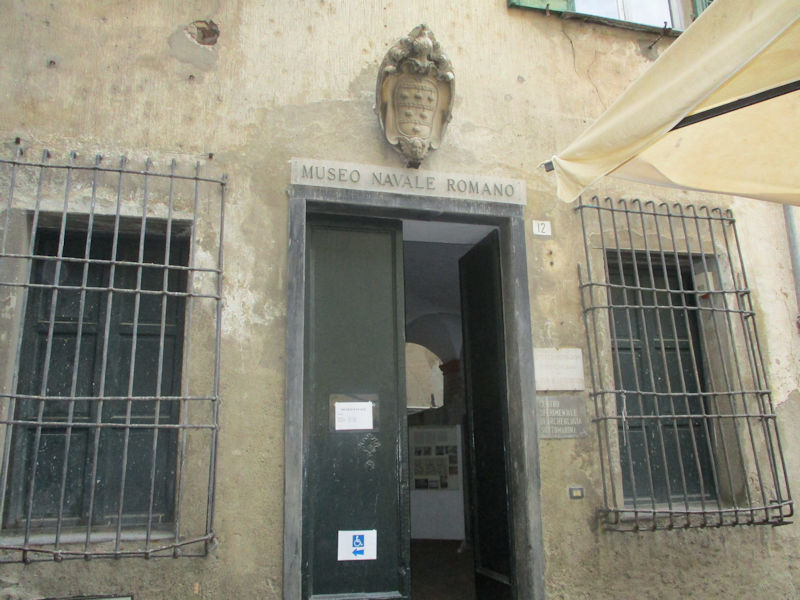
The naval history museum -- it looks open but it's closed.
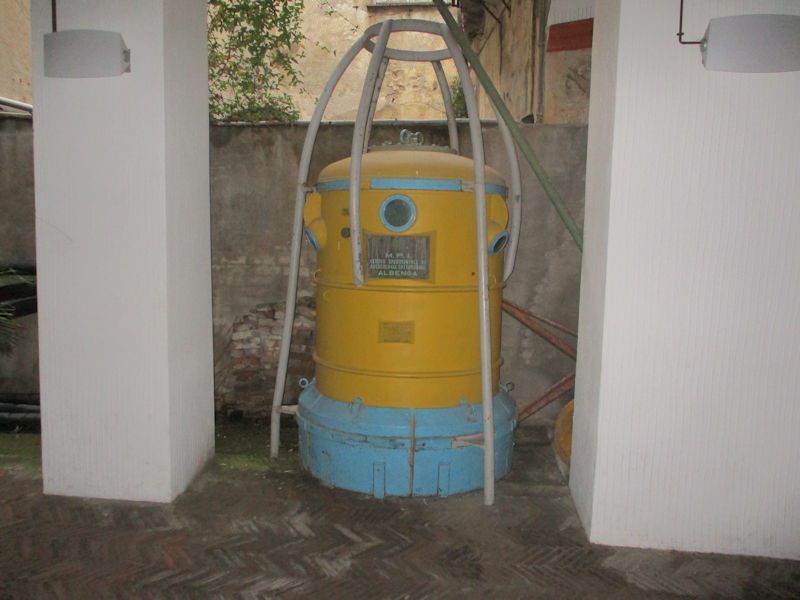
Except for the lobby, with its diving bell
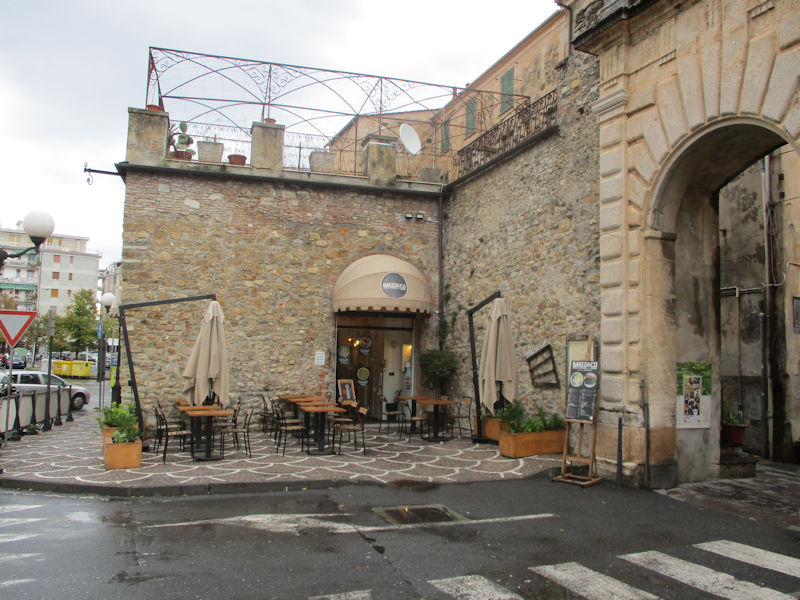
We've just trotted back to reunite our party at the jacket potatoes emporium, but no luck, alas.
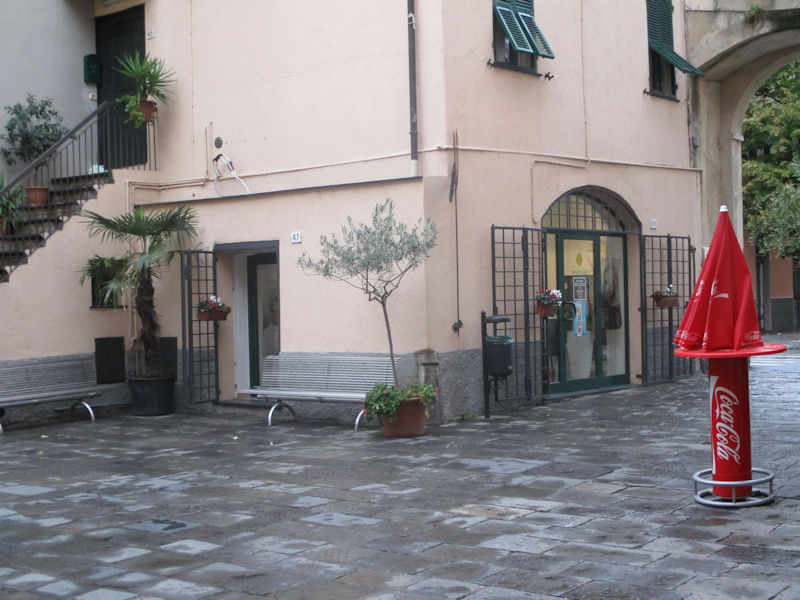
But our name rings out heartily from the hair salon next door, so we settle down to wait in the adjacent coffee bar.
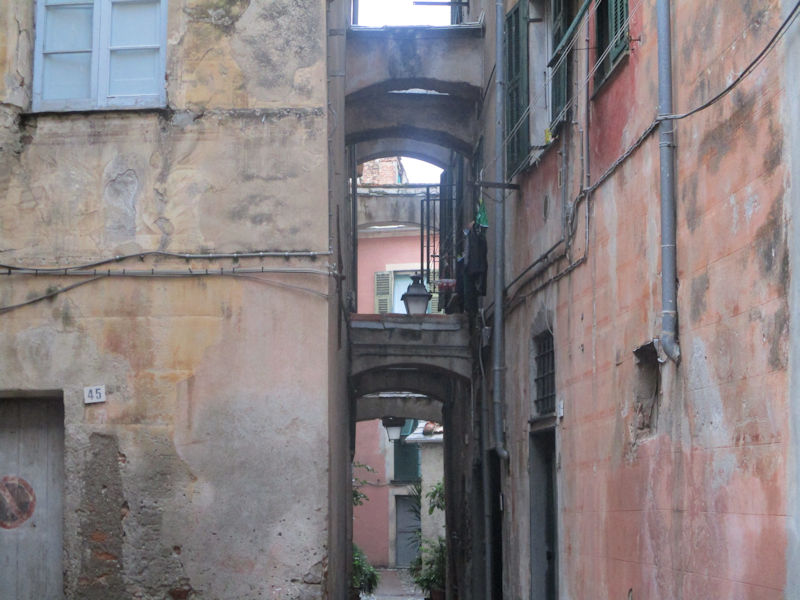
Further investigations. Under the jurisdiction of various powers over succeeding centuries, including the Visconti 1355 to 1379, and again of Genoa, Albenga was occupied by the Duchy of Savoy in 1625 and 1746. Napoleon made it the capital of its own province, which was continued under the Kingdom of Sardinia until 1859 and under the unified Italy until 1926. Since then it's been part of the province of Savona in the Ligurian region, by which time however it had been reduced to the status of a small agricultural town and tourist destination.
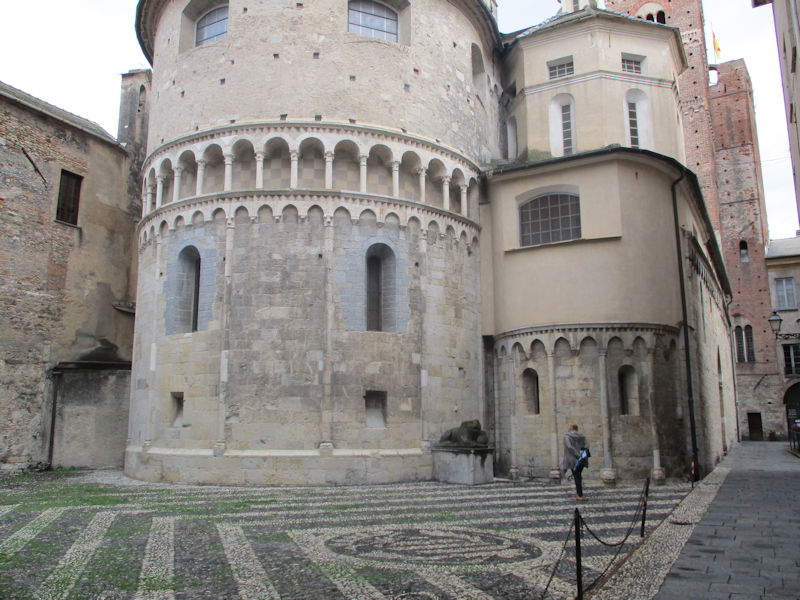
The back of the Duomo, in the Piazzetta dei Leoni, or little piazza of the lions, between the apse of the Duomo and the residence of the important Costa family who installed the three lions in 1608.

This is dedicated to our growing collection of "Kristin sticking her hand into the lion's mouth".
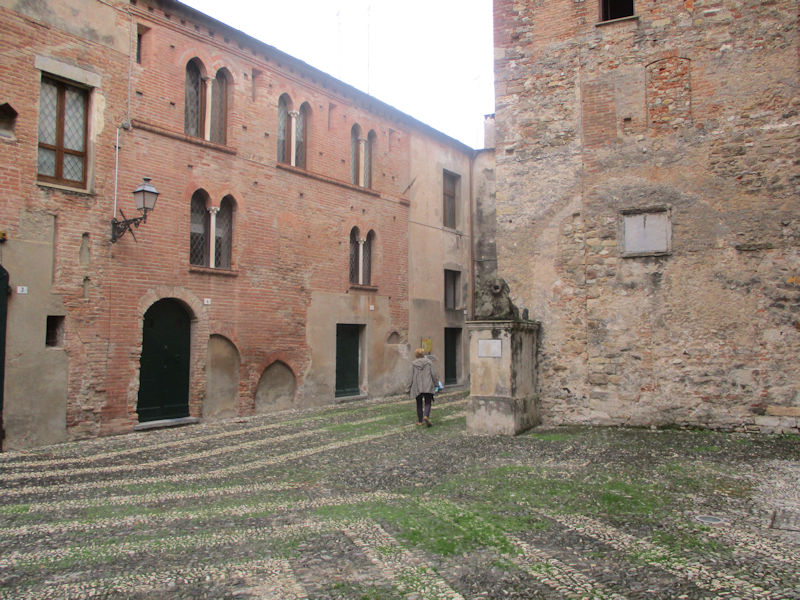
The Piazzetta of the Lions. To be honest, we're just looking for the Baptistery.

That's part of the old City Hall, with its campanile and Ghibelline-style 'swallowtail' battlements -- and the Baptistery on the right.

The early Christian Baptistery, adjacent to the Duomo, was built in the early- to mid-400s in a late-Roman style with an interesting mosaic that recalls the Byzantine mosaic style of Ravenna, etc. Externally, it is ten-sided, but octagonal within. The structure is some two metres below the present street level, at the early ground level of its own time.

Part of the diocesan buildings around the Duomo
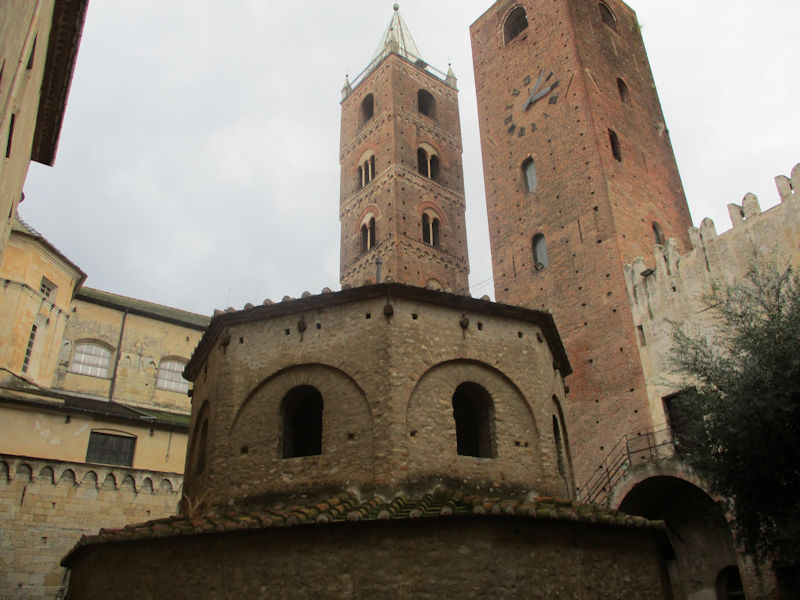
The Baptistery with the bell- and clock tower of the Duomo and old City Hall
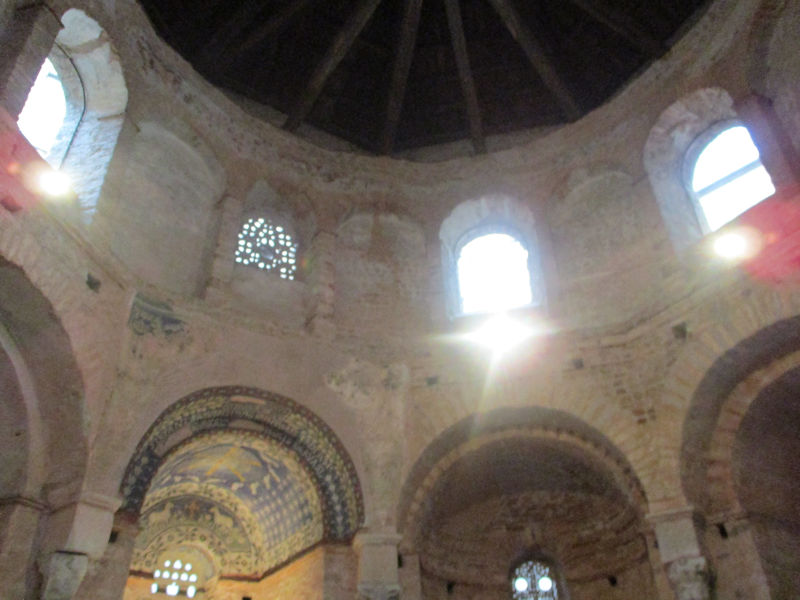
The interior -- the structure has been described as 'the oldest [Christian] building in Liguria still standing as well as being one of the best preserved baptisteries in Italy' (Italian Wikipedia). It was lovingly and conservatively restored in the late 19th century by a famous architect who's credited with its present condition and its strong effect on the viewer.
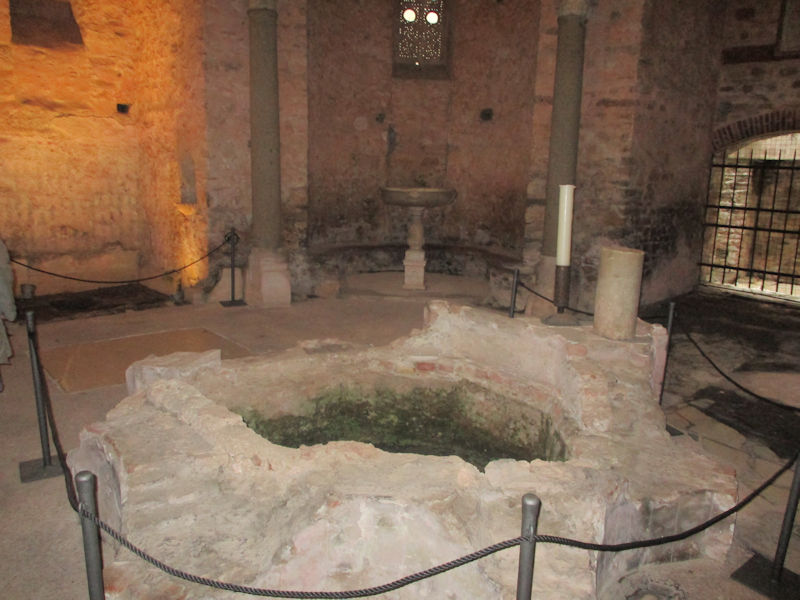
The immersion baptismal font in the centre, octagonal on the inside and star-shaped on the outside

15th century frescoes on the walls are largely faded out, but the 5th century mosaic in its niche is vivid.

It shows the Alpha/Omega in the centre surrounded by three concentric circles for the Trinity and 12 doves for the apostles. Apparently the text identifies various relics held in the associated church at that time.
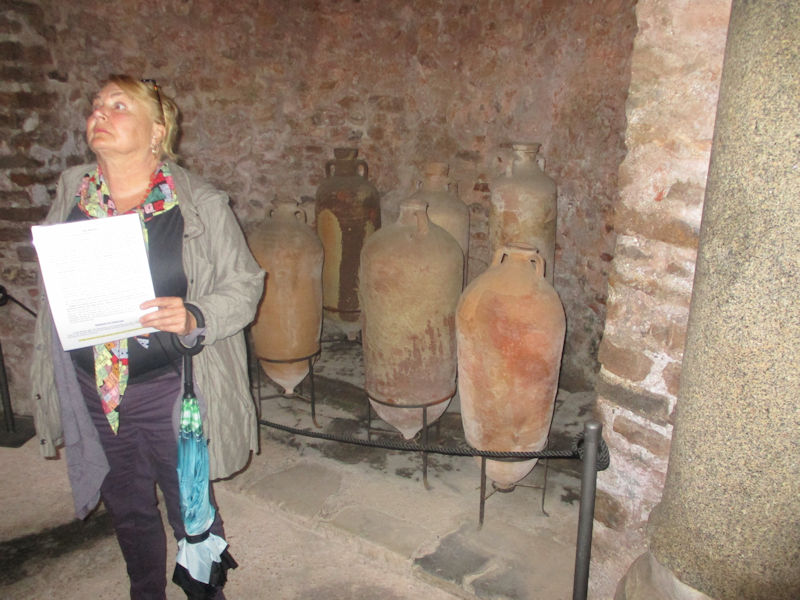
There was an explanation for the amphorae, but I've forgotten it.

The front door of the Baptistery and a set of stairs into the old City Hall

Towers above

We and our German fellow tourists are pursuing our guide up into the diocesan museum in the old Bishop's Palace.

The Museo Diocesano is a 'No Photo' and indeed even 'No Flash' establishment, which presumably means that the ecclesiastical authorities are concerned to keep up the postcard sales. So we bought some postcards, and here are a few of my favorites. This strange Madonna and Child is identified as created by a 13th century stonecutter from Como.
On the left is the 'pride of the collection', according to the info sheet, a Martyrdom of Catherine of Alexandria (ca. 1606) by the Baroque-era artist Guido Reni, one of our favorite artists though not one of our favorite works of his. On the right is a silver processional statue of St Michael the Archangel, doing what he does best, from late 18th century Genoa.

Now, at last, for the Romanesque and Gothic Duomo, the Cathedral of St Michael the Archangel, built in the late 11th century over a late 4th century predecessor, and to the same dimensions, with significant alterations during the communal period of the late 12th and early 13th century.

Photos of the interior, with a nave and two aisles, but not this photo, show very beautiful rows of arches and columns and a roof covered with frescoes from the 19th century. This photo shows the nave and altar with the PaintShop Pro brightness control turned up high -- to the human eye, it was nearly pitch black. Cost-cutting measures.

A 17th century chapel on the right

A fresco of St Clare of Assisi, founder of the Order of the Poor Clares and since 1958 the patron saint of television.
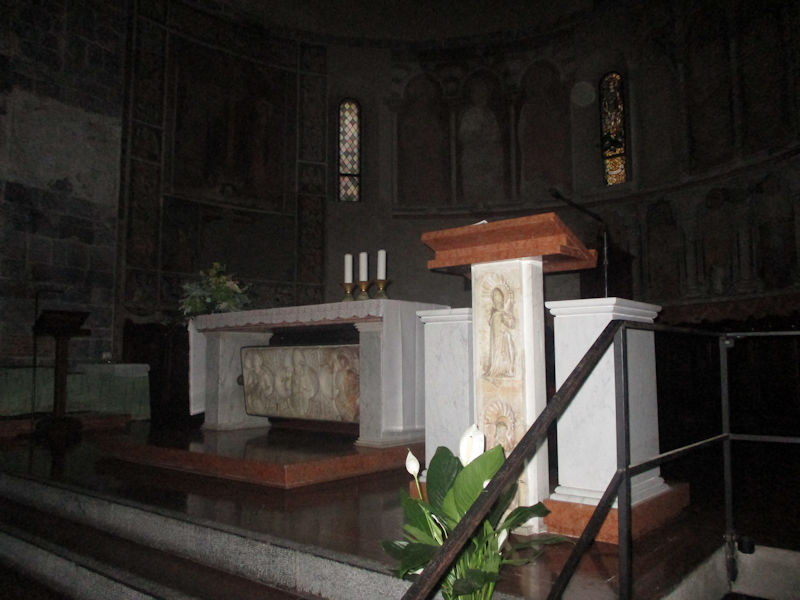
The modern altar in the presbytery, with 16th century works showing Saints Veranus, Michael, and John
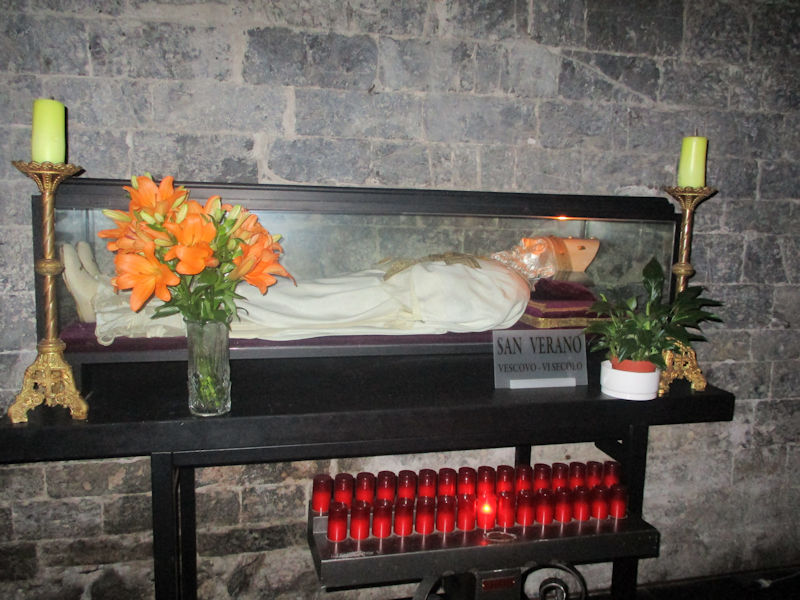
That's St Veranus of Cavaillon (d. 590) from the Vaucluse in southeastern France, a Bishop of Cavaillon there who was well remembered for his charitable works and for expelling dragons. He had a particular affection for Albenga, it's said, and was instrumental in converting the city to Christianity (though he seems to have done that about 200 years after its first cathedral was built). His relics were brought to Orléans at some point but transferred in the 13th century to the Cavaillon Cathedral, though at the same time some of his bits and pieces were sent here to Albenga.


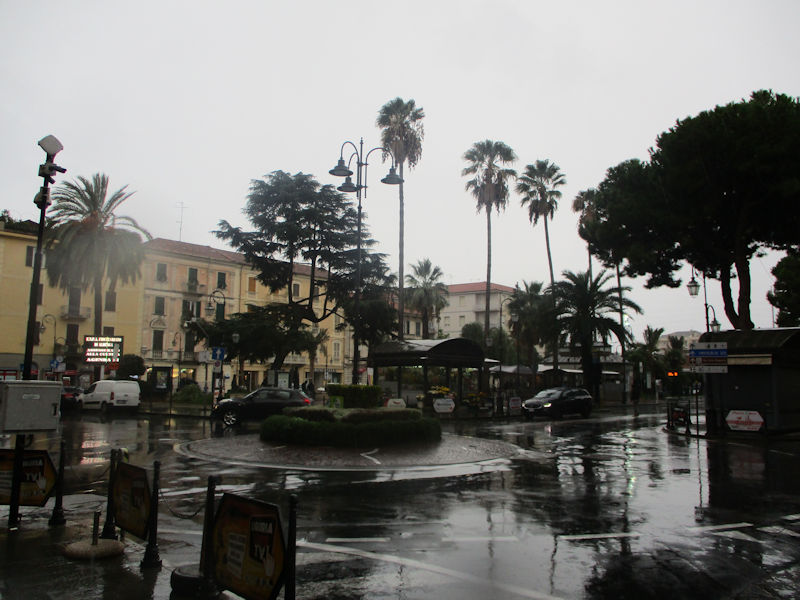
It's raining somewhat harder now, so we'll race back across the old town and buy some cat food.

A cat food stop in the supermarket facing the western gateway to the old town -- we're bound now for the autostrada up the A10 to Savona and north on the A6 Torino road to Mondovì.

Time for dinner. What's on for tomorrow? Not much, as it turned out -- two days of serious rain, good for catching up on our reading. The weather is turning dangerously awful all over Italy, with major flooding and destruction in Rome, Venice, etc. And not so good for Genoa, probably, already missing its autostrada bridge.

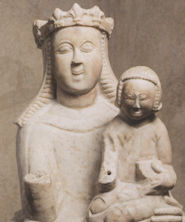 Dwight Peck's personal website
Dwight Peck's personal website

























































